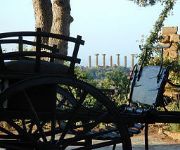Facts and Data
Webpages:
Official Unesco Page
View photos from OUR PLACE the World Heritage collection
www.comhera.org
Agrigento e Provincia On Line (only in Italian)
Basis Data:
Unesco World heritage since: 1997
Size of heritage: 934 ha
- Buffer zone: 1,869 ha
Coordinates:
Longitude: 13,593°
Latitude: 37,290°
Summary
Founded as a Greek colony in the 6th century B.C., Agrigento became one of the leading cities in the Mediterranean world. Its supremacy and pride are demonstrated by the remains of the magnificent Doric temples that dominate the ancient town, much of which still lies intact under today's fields and orchards. Selected excavated areas throw light on the later Hellenistic and Roman town and the burial practices of its early Christian inhabitants.
Location on Map
Show bigger map on Openstreetmap
Archaeological Area of Agrigento
The Archaeological Area of Agrigento, located in the Province of Agrigento in Sicily, Italy, is a UNESCO World Heritage site that showcases the remains of the ancient Greek city of Akragas. This archaeological site is renowned for its exceptional state of preservation and its outstanding examples of Doric architecture.
History
The history of the Archaeological Area of Agrigento dates back to the 6th century BC when it was founded as a Greek colony by settlers from Gela. The city, known as Akragas, flourished during the 5th century BC and became one of the most important Greek colonies in Sicily. It was a prosperous city with a strong economy based on agriculture, trade, and craftsmanship.
Akragas was known for its magnificent temples, which were built to honor the gods and demonstrate the city's wealth and power. The most famous of these temples is the Temple of Concordia, which is remarkably well-preserved and considered one of the best-preserved Doric temples in the world. Other notable temples include the Temple of Juno, the Temple of Heracles, and the Temple of Olympian Zeus.
During the Roman period, Akragas declined in importance and was eventually abandoned. Over the centuries, the city was buried under layers of sediment and forgotten. It was not until the 18th century that the archaeological site was rediscovered and excavations began.
Current State
The Archaeological Area of Agrigento is now a vast open-air museum that covers approximately 1,300 hectares. It is divided into three main areas: the Valley of the Temples, the Kolymbetra Garden, and the Archaeological Museum.
The Valley of the Temples is the most famous and impressive part of the site. It is home to the well-preserved temples, including the Temple of Concordia, which is the highlight of the area. Visitors can explore the ruins of the temples and admire the intricate Doric architecture. The site offers breathtaking views of the surrounding countryside and the Mediterranean Sea.
The Kolymbetra Garden, located in the eastern part of the site, is a beautiful garden that was once an ancient water reservoir. It has been restored and transformed into a lush oasis with citrus and olive trees, aromatic plants, and colorful flowers. Visitors can stroll through the garden and enjoy its peaceful atmosphere.
The Archaeological Museum, located near the entrance of the site, houses a collection of artifacts found during the excavations. It provides valuable insights into the history and daily life of the ancient city of Akragas.
The Archaeological Area of Agrigento is not only a testament to the rich history of ancient Greece but also a symbol of the cultural heritage of Sicily. Its exceptional state of preservation and its architectural beauty make it a must-visit destination for history enthusiasts and anyone interested in ancient civilizations.
Hotels and places to stay
Villa Athena Hotel
Colleverde Park Hotel
Della Valle Hotel
Demetra Resort
Exclusive
Del Viale
B&B Agorà
B&B Villa San Marco
Villa dei Giardini
La Dolce Vita B&B
Videos from the area
Videos provided by Youtube are under the copyright of their owners.
















